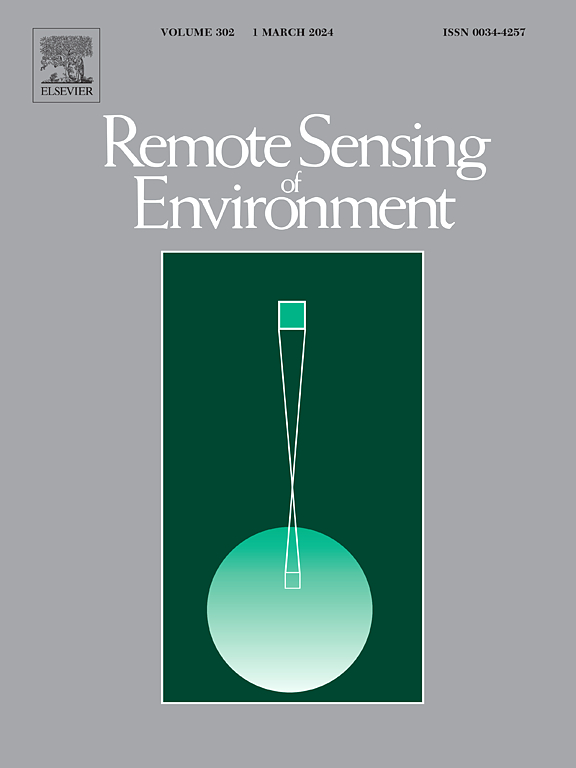Rapid changes in terrestrial carbon dioxide uptake captured in near-real time from a geostationary satellite: The ALIVE framework
IF 11.1
1区 地球科学
Q1 ENVIRONMENTAL SCIENCES
引用次数: 0
Abstract
The terrestrial carbon cycle responds to human activity, ecosystem dynamics, and weather and climate variability including extreme events. Satellite remote sensing has transformed our ability to estimate ecosystem carbon dioxide uptake, the gross primary productivity (GPP), with increasing accuracy and spatial resolution. Many aspects of terrestrial carbon cycling happen quickly on sub-daily or daily scales. These dynamics may not be captured at the temporal scales of typical remote sensing products from polar orbiting satellites – often multiple days or longer. Imagers onboard geostationary satellites measure the Earth system at “hypertemporal” time scales of minutes or less and often have the spectral capabilities to estimate GPP and other surface-atmosphere fluxes using established approaches. Here, we use observations and data products from the Advanced Baseline Imager (ABI) on the Geostationary Environmental Operational Satellite – R Series (GOES-R) to create ALIVEGPP (Advanced Baseline Imager Live Imaging of Vegetated Ecosystems), a GPP product that provides open data on the native five-minute basis of GOES-R CONUS scenes with latency under one day. Our machine learning model, trained on GPP estimates from 111 eddy covariance flux towers with 276 site-years of data spanning tropical to boreal ecosystems, captures up to 70 % of the observed variability when 20 % of tower sites are withheld, with R2 values of 0.78 (0.82) when aggregating to daily (weekly) periods. We compared ALIVEGPP predictions against eight-day MODIS MOD17A2 GPP estimates and daily GPP estimates from the Breathing Earth System Simulator v2 (BESSv2) and demonstrate how ALIVEGPP simulates the impacts of phenological transitions, flash drought, and hurricanes. Advancements to geostationary satellite imagery, machine learning, and cloud computing make it possible to estimate carbon flux in near real-time and provide new ways to understand the ever-changing carbon cycle and the processes that define it.
地球同步卫星近实时捕获的陆地二氧化碳吸收的快速变化:ALIVE框架
陆地碳循环响应人类活动、生态系统动态、天气和气候变化,包括极端事件。卫星遥感已经改变了我们估计生态系统二氧化碳吸收量的能力,即总初级生产力(GPP),其精度和空间分辨率不断提高。陆地碳循环的许多方面在亚日或日尺度上迅速发生。这些动态可能无法在极轨卫星的典型遥感产品的时间尺度上捕捉到——通常是数天或更长时间。地球静止卫星上的成像仪以分钟或更短的“超时”时间尺度测量地球系统,并且通常具有使用既定方法估计GPP和其他地表大气通量的光谱能力。在这里,我们使用地球同步环境业务卫星-R系列(GOES-R)上的高级基线成像仪(ABI)的观测和数据产品创建了ALIVEGPP(植被生态系统的高级基线成像仪实时成像),这是一种GPP产品,提供以GOES-R CONUS场景为基础的5分钟开放数据,延迟不到一天。我们的机器学习模型是根据111个涡动相关通量塔的GPP估计进行训练的,这些塔具有276个站点年的数据,涵盖热带到北方生态系统,当保留20%的塔点时,可以捕获高达70%的观察到的变异性,当聚合到每天(每周)时,R2值为0.78(0.82)。我们将ALIVEGPP预测与8天MODIS MOD17A2 GPP估计和呼吸地球系统模拟器v2 (BESSv2)的每日GPP估计进行了比较,并演示了ALIVEGPP如何模拟物候转变、暴发性干旱和飓风的影响。地球同步卫星图像、机器学习和云计算方面的进步使近乎实时地估计碳通量成为可能,并提供了了解不断变化的碳循环及其定义过程的新方法。
本文章由计算机程序翻译,如有差异,请以英文原文为准。
求助全文
约1分钟内获得全文
求助全文
来源期刊

Remote Sensing of Environment
环境科学-成像科学与照相技术
CiteScore
25.10
自引率
8.90%
发文量
455
审稿时长
53 days
期刊介绍:
Remote Sensing of Environment (RSE) serves the Earth observation community by disseminating results on the theory, science, applications, and technology that contribute to advancing the field of remote sensing. With a thoroughly interdisciplinary approach, RSE encompasses terrestrial, oceanic, and atmospheric sensing.
The journal emphasizes biophysical and quantitative approaches to remote sensing at local to global scales, covering a diverse range of applications and techniques.
RSE serves as a vital platform for the exchange of knowledge and advancements in the dynamic field of remote sensing.
 求助内容:
求助内容: 应助结果提醒方式:
应助结果提醒方式:


